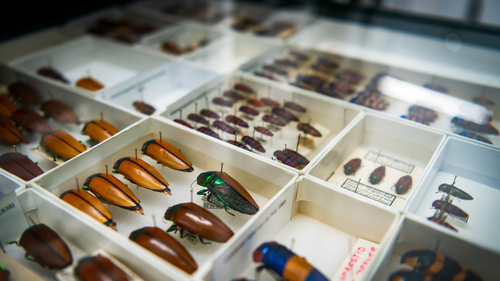<div class="block-content"><div class="styles__Container-sc-1ylecsg-0 goULFa"><span>Millions of insects and wildlife species will now be housed under the one roof in Canberra in a "library of life on Earth".</span></div></div><div class="block-content"><div class="styles__Container-sc-1ylecsg-0 goULFa"><span>The new $90 million CSIRO facility, named Diversity, is designed to hold 13 million wildlife and insect specimens collected over the past 150 years. </span></div></div><div class="block-content"><div class="styles__Container-sc-1ylecsg-0 goULFa"><span>The purpose-built laboratory is consolidating the irreplaceable specimens for the first time, aiming to drive scientific discoveries for future generations, and will support research informing biosecurity policy, pest management, disease prevention, and the impact of climate change. </span></div></div><div><div id="adspot-mobile-medium"></div></div><div class="block-content"><div class="styles__Container-sc-1ylecsg-0 goULFa"><strong><span>READ MORE: </span></strong><a href="https://www.9news.com.au/national/anthony-albanese-jodie-haydon-wedding-details-no-world-leaders/f15fec7e-907d-413d-924a-652bd962df01"><strong><span>No world leaders allowed: Albanese reveals new details about wedding</span></strong></a><strong><span></span></strong></div></div><div class="block-content"><div class="styles__Container-sc-1ylecsg-0 goULFa"><span>"It puts together a picture of how Australia's biodiversity is changing and we can learn from those trends and potentially predict what's going to happen in the future," Dr Clare Holleley from the CSIRO said.</span></div></div><div class="block-content"><div class="styles__Container-sc-1ylecsg-0 goULFa"><span>A new genomics laboratory and digitisation suite will allow scientists, as well as citizen scientists, access to specimen data online, including DNA sequences and high-resolution images. </span></div></div><div class="block-content"><div class="styles__Container-sc-1ylecsg-0 goULFa"><span>"What we have here is a facility that holds specimens in a highly secure way and allows us to digitise and automate digitisation in a way that is just the envy of the world," CSIRO chief executive Dr Doug Hilton said.</span></div></div><div><div class="OUTBRAIN" data-reactroot="" data-src="//www.9news.com.au/national/csiro-diversity-facility-insect-wildlife-specimens/9320d9f6-0136-4a1b-81ab-63391f2edd83" data-widget-id="AR_5"></div></div><div class="block-content"><div class="styles__Container-sc-1ylecsg-0 goULFa"><strong><span>READ MORE: </span></strong><a href="https://www.9news.com.au/finance/ampol-eg-group/6450c950-318e-4654-8307-bf5d9c5c16a1"><strong><span>Popular Aussie servos set for $1 billion transformation</span></strong></a><strong><span></span></strong></div></div><div class="block-content"><div class="styles__Container-sc-1ylecsg-0 goULFa"><span>It took around a year to relocate the 13 million specimens to their new home, and while the building is not open to the public, it will be accessible to scientists from across Australia and the world. </span></div></div><div class="block-content"><div class="styles__Container-sc-1ylecsg-0 goULFa"><span>"We have a fire-rated vault, we are earthquake-proof," Holleley said.</span></div></div><div class="block-content"><div class="styles__Container-sc-1ylecsg-0 goULFa"><span>"So scientists like me, in 100 years, will be able to look back at the things we've collected today."</span></div></div><div class="block-content"><div class="styles__Container-sc-1ylecsg-0 goULFa"><em><span>This article was produced with the assistance of </span></em><a href="https://www.9news.com.au/technology/9express/16480c33-636a-461f-9c4f-d0e2522c722a"><em><span>9ExPress</span></em></a><em><span>.</span></em></div></div>
New $90 million facility to house millions of insect and wildlife samples

Leave A Reply
Your email address will not be published.*